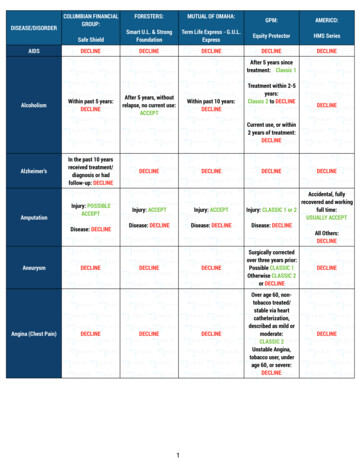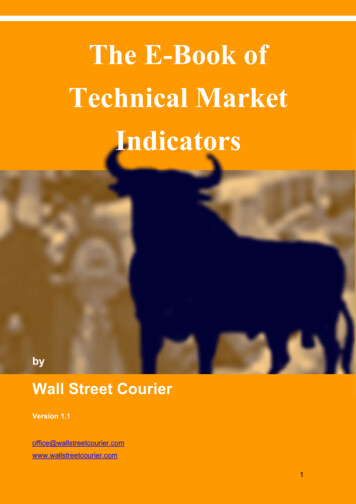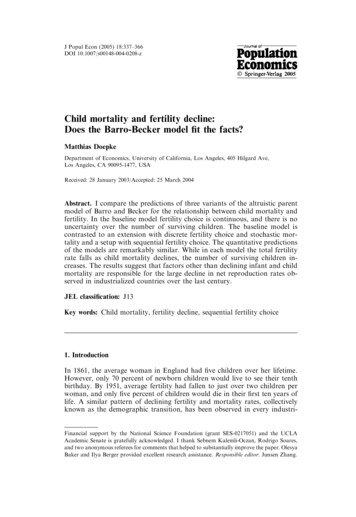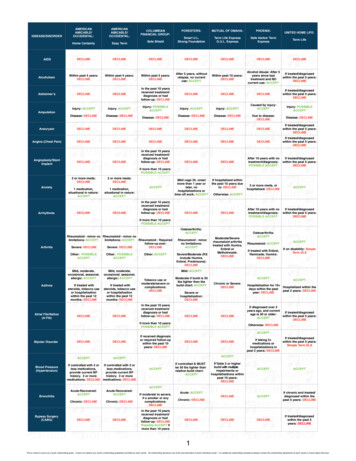
Transcription
Public Disclosure AuthorizedPublic Disclosure AuthorizedPublic Disclosure AuthorizedPublic Disclosure AuthorizedFINANCE, COMPETITIVENESS & INNOVATION INSIGHT FINANCIAL STABILITY & INTEGRITYThe Decline in Access to CorrespondentBanking Services in Emerging Markets:Trends, Impacts, and SolutionsLessons Learned from Eight Country Case Studies
2018 The World Bank Group1818 H Street NWWashington, DC 20433Telephone: 202-473-1000Internet: www.worldbank.orgAll rights reserved.This volume is a product of the staff of the World Bank Group. The World Bank Group refersto the member institutions of the World Bank Group: The World Bank (International Bank forReconstruction and Development); International Finance Corporation (IFC); and MultilateralInvestment Guarantee Agency (MIGA), which are separate and distinct legal entities eachorganized under its respective Articles of Agreement. We encourage use for educational andnon-commercial purposes.The findings, interpretations, and conclusions expressed in this volume do not necessarilyreflect the views of the Directors or Executive Directors of the respective institutions of the WorldBank Group or the governments they represent. The World Bank Group does not guarantee theaccuracy of the data included in this work.Rights and PermissionsThe material in this publication is copyrighted. Copying and/or transmitting portions or all ofthis work without permission may be a violation of applicable law. The World Bank encouragesdissemination of its work and will normally grant permission to reproduce portions of the workpromptly.All queries on rights and licenses, including subsidiary rights, should be addressed to theOffice of the Publisher, The World Bank Group, 1818 H Street NW, Washington, DC 20433, USA;fax: 202-522-2422; e-mail: pubrights@worldbank.org.Photo Credit: iStock
FINANCE, COMPETITIVENESS & INNOVATION INSIGHT FINANCIAL STABILITY & INTEGRITYTABLE OF CONTENTSABBREVIATIONS AND ACRONYMSIIIACKNOWLEDGMENTSVEXECUTIVE SUMMARYVIII. INTRODUCTION1II. METHODOLOGY AND SCOPE3III. MAIN OUTCOMES OF THE COUNTRY CASE STUDIES53.1 The termination or restriction of CBRs in the banking sector53.2 The termination or restriction of accounts in the remittances market93.3 Impact on various types of customers, products, and services113.4 The cross-border effects of derisking143.5 Other potential implications of CBR terminations15IV. POSSIBLE SOLUTIONS AND GOOD PRACTICES174.1 The role of the public sector174.2 The role of the private sector214.3 The potential of Fintech to address the derisking problem23CONCLUSION33ENDNOTES35THE DECLINE IN ACCESS TO CORRESPONDENT BANKING SERVICES IN EMERGING MARKETSI
BOXESBox 1. The effect of CBR terminations on a banks’ ratingsBox 2. Improvements to AML/CFT regimes: the case of Somalia18Box 3. e-KYC: The case of India23Box 4. KYC utilities: The case of Mexico25Box 5. The case of Singapore28Box 6. Examples of alternatives solutions to correspondent banking29FIGURESFigure 1. Causes to terminate or restrict CBRs in one of the surveyed countries6Figure 2. Summary of steps for regulating and supervising remittance markets21Figure 3. The database architecture26Figure 4. The KYC utility architecture27Figure 5. Current and alternative settlement flows30TABLESTable 1. Summary of survey on account closures in one surveyed countryTable 2. Remittance operating account closures, 2010–2017, in one surveyed countryII8TABLE OF CONTENTS710
FINANCE, COMPETITIVENESS & INNOVATION INSIGHT FINANCIAL STABILITY & INTEGRITYACRONYMS AND ABBREVIATIONSAUDAustralian dollarAML/CFTAnti-Money Laundering and Combating the Financing of TerrorismBBABritish Bankers AssociationBdMBanco de MexicoBISBank for International SettlementsCBRcorrespondent banking relationshipCBSCentral Bank of SomaliaCDDcustomer due diligenceCFGCharity Finance GroupCNYChinese yuanCPMICommittee on Payments and Market InfrastructuresDFIDDepartment for International DevelopmentEAPEast Asia and PacificEUEuropean UnionEUReuroFATFFinancial Action Task ForceFintechfinancial technologyFSBFinancial Stability BoardGDPgross domestic productIDBInter-American Development BankIFCInternational Finance CorporationIMFInternational Monetary FundISOInternational Organization for StandardizationJPYJapanese yenKYCknow your customerKYCCknow your customer’s customerKYCCCknow your customer’s customers’ customerLACLatin America and the CaribbeanMASMonetary Authority of SingaporeML/FTmoney laundering/financing of terrorismTHE DECLINE IN ACCESS TO CORRESPONDENT BANKING SERVICES IN EMERGING MARKETSIII
IVMTOsmoney transfer operatorsNGOnongovernmental organizationsNPOnonprofit organizationsNZDNew Zealand dollarsOECDOrganisation for Economic Co-operation and DevelopmentRBArisk-based approachRMArelation management applicationRSPremittance service providerSASouth AsiaSMEsmall- and medium-scale enterpriseSSASub-Saharan AfricaSWIFTSociety for Worldwide Interbank Financial TelecommunicationTDBTonga Development BankUAEUnited Arab EmiratesUSDUnited States dollarWBGWorld Bank GroupACRONYMS AND ABBREVIATIONS
FINANCE, COMPETITIVENESS & INNOVATION INSIGHT FINANCIAL STABILITY & INTEGRITYACKNOWLEDGMENTSThis paper was written by Pierre-Laurent Chatain, Emile Van der Does de Willebois, InesGonzalez del Mazo, Ricardo David Valencia, Ana Maria Aviles, Karol Karpinski, andSameer Goyal; Carlo Corazza, Priyani Malik, and Isaku Endo (all World Bank). Sue E.Eckert and Don Abel (consultants) also contributed.The authors are thankful to their counterpartsin the countries listed here for their hospitality,cooperation, and responses to the questionnairesand follow-up discussions. The team wishes toextend its gratitude to the following: Bangladesh—Kamal Hossain (Joint Director,Bangladesh Financial Intelligence Unit, CentralBank of Bangladesh) Guatemala—JoseAlejandroArévalo(Superintendent of Banks) and Silvia E. VillatoroCalderón (Assistant to the Superintendent,Superintendency of Banks [SIB]) Mexico—Manuel M. A. Díaz (Director ofPayment Systems, Banco de México) Philippines—NestorEspenilla(Governor,Central Bank of the Philippines) Samoa—Maiava A. Ainuu-Enari (Governor,Central Bank of Samoa) South Africa—Daniel Mminele (DeputyGovernor, South African Reserve Bank), IsmailMomoniat (Head of Tax and Financial SectorPolicy at the National Treasury), and RoyHavemann and Keegan Edwards (the NationalTreasury) Tonga—Sione Ngongo Kioa (Governor, NationalReserve Bank of Tonga) Jamaica—Maurene Simms (Deputy Governor,Financial Institutions Supervisory Division atBank of Jamaica) and George Roper (SupervisionEvaluation Expert)We would like to thank the following colleagues fordiscussions and suggestions: Ceyla Pazarbasioglu,Alfonso Garcia Mora, Aurora Ferrari, Yira Mascaro,Andy Jobst, Zafer Mustafaoglu, Cecile ThioroNiang, Emily Adeleke, Harish Natarajan, JeanPesme, Stuart Yikona, Cédric Mousset, KuntayCelik, and Krishnamurti Damodaran (all WorldBank).In addition to their suggestions, we would liketo thank the following World Bank colleaguesfor their help in liaising with the authorities andcountry offices: Zafer Mustafaoglu and LeylaCastillo (Guatemala); Niraj Verma and PriyaniMalik (Bangladesh); Alejandro de la Campa,Gunhild Berg, and Julie Dana (South Africa);Cecile Thioro Niang, Galina Sotirova, and BujanaPerolli (Jamaica); John Vivian, Tatafu Moeaki, andElizabeth Ika (Tonga); John Vivian and AntoniaWong (Samoa); and Jennifer Isern and ReinaluzOna (Philippines).The team also wants to extend its gratitude to theKorean government for its financial support throughthe Seoul Center for Financial Sector Development.This paper summarizes the main outcomes ofeight country case studies carried out from Aprilto November 2017. Each visit led to the productionof an aide-memoire for the authorities. Becauseof confidentiality restrictions, the countrycases did not lead to a specific publication, andtherefore the results have been made anonymousin the present report.THE DECLINE IN ACCESS TO CORRESPONDENT BANKING SERVICES IN EMERGING MARKETSV
VIACRONYMS AND ABBREVIATIONS
FINANCE, COMPETITIVENESS & INNOVATION INSIGHT FINANCIAL STABILITY & INTEGRITYEXECUTIVE SUMMARYTo move funds internationally, banks rely on correspondent banking relationships(CBRs), roughly defined as the provision of banking services by one bank (thecorrespondent) to another bank (the respondent). CBRs are essential to internationalpayments and provide an essential nexus between local economies and jurisdictions and theinternational financial system. They underpin international trade, remittances, and humanitarianfinancial flows among countries and are therefore particularly relevant to developing countries tosupport economic growth and development.Since the global financial crisis of 2008, globalbanks have been reviewing their CBRs andmany have decided to terminate or limit theircorrespondent banking services (also known asderisking) to different regions, jurisdictions, orcategories of clients. That process is still takingplace, and all countries in this survey reported casesof derisking. This response is true for both localrespondent banks and money transfer operators(MTOs). But, as this study confirms, the effectsdiffer significantly from institution to institutionand from country to country. In small islandsstates, the impact of the decline in CBRs has beenacute. While those involved in the global debatetacitly assume that large banks have left regions orcountries altogether, our study shows that, in fact,the process is more selective. Global banks havederisked certain banks, but they have also orientedand trained others in the same countries, suggestingthat their decisions to terminate a relationshipwere not exclusively motivated by jurisdictionalconcerns.In some cases, derisking is justified. Althoughthe loss of critical financial services in a countryis a cause for concern and may require authorities’intervention to protect the interest of those affected,there are instances when a global bank is justified interminating certain relationships. A case in point isthe derisking of a prominent respondent bank by allits foreign correspondents following the dismissalof the top management team for money launderingand corruption offenses.Overall, in the eight countries covered in thisstudy, the macroeconomic impact of deriskingappears limited. In a few countries, the net lossof CBRs has been marginal, and the impact hasremained contained. Banks have been able tocope with the situation by dealing with fewercorrespondent banks or establishing new ones,but this process can be cumbersome. In addition,in many cases the terms and conditions of newlyestablished CBRs were significantly moreunfavorable than under previous relationships,which confirms findings from the 2015 World Banksurvey on correspondent banking.1While more robust vigilance of correspondentbanking channels is encouraged, maintaining CBRscomes at a cost to both correspondent and respondentbanks. Rising compliance costs associated with morestringent Anti-Money Laundering and Combatingthe Financing of Terrorism (AML/CFT) regulationsand international sanctions regimes makes theprovision of correspondent banking services aless financially attractive business proposition. Allbankers interviewed for this study acknowledgedthat correspondent accounts, including the newones, cost much more to maintain, thus requiringlarger transactions volume and fees to remain aviable activity.THE DECLINE IN ACCESS TO CORRESPONDENT BANKING SERVICES IN EMERGING MARKETSVII
The study shows that the effect of derisking hasbeen felt at the microlevel, sometimes intensively.On a few rare occasions, banks nearly lost theiraccess to the international financial system. Impactsfor banks include, among other things, (a) the loss ofsignificant numbers of customers, mostly corporatecompanies and exporters; (b) a significant drop inremittance volumes; (c) the loss of highly profitablebusinesses, such as the supply of the United Statesdollar (USD) to certain countries; and (d) adverseeffects on banks’ ratings.However, the effect on banks’ customersis currently limited for costs, despite a fewexceptions. The increase in costs generatedby higher due diligence related to AML/CFTregulations is rarely passed on to banks’ clientsand is typically absorbed by the banks or moneytransfer operators (MTOs). There are cases, though,where clients have been affected significantly. Inone country, for example, a bank indicated that itscosts per transaction in switching CBRs had risenfrom USD 9 to USD 50–60.MTOs have been particularly affected byderisking because of their cash-intensivebusiness. In almost all surveyed countries, anumber of respondent banks received instructionsfrom their correspondent banks not to serviceMTOs anymore, and financial services providedby MTOs are precisely the type of cross-borderfinancial services intensively used in less financiallydeveloped countries. MTOs’ accounts were closed,and this action has disrupted the operations of manyoperators.Foreign exchange traders, another cashintensive business, have also been significantlyaffected. In one country for example, at the end of2014, 80 percent of foreign exchange traders hadforeign currency accounts with local banks; by2017, this number had dropped to 51 percent.Although cash-intensive businesses have foundalternatives, these expose MTOs to higher risksand uncertainty. To remain in business, somebusinesses have resorted to unconventional methodsVIIIEXECUTIVE SUMMARYsuch as the use of personal bank accounts to channelmoney or the use of commercial couriers to carrycash between sending and receiving countries. Inthe long term, these alternatives are not sustainableor desirable.The direct effect of derisking on remittances,for the cost of making remittances and enablinginflows, is still unclear. While some countries inwhich remittance companies have lost accountsexperienced an increase of their average cost ofmaking remittances in the past year, others haveseen a decrease. Additionally, four of the eightvisited countries have experienced a decrease in thevolume of remittance inflows in the past five years,while the other four have shown a steady increaseyear after year. Therefore, the overall picture isdecidedly mixed, and further analysis is needed tounderstand the different underlying factors (suchas geopolitical risks and oil prices) that may affectcosts and inflows. In this regard, the work currentlybeing undertaken by the Financial Stability Boardon remittances is very timely and opportune.Derisking has also had cross-border spillovereffects, especially in the Southern AfricanDevelopment Community. Pan-African bankshave been under pressure from their correspondentsto stop doing certain business (for example,supplying foreign currencies) in neighboringcountries to maintain their CBRs. Consequently,USD clearing has been terminated or restricted inseveral countries, which in turn further weakenslocal economies.Even though the study did not find anymacroeconomic effects in any of the eightvisited countries, the existence of significantmicroeffects and business distortions warrantsfurther attention. First, there is a trend toward aconcentration of correspondent banking serviceswith fewer institutions handling larger volumes,leading to the buildup of counterparty risks. Second,the concentration of MTOs and remittances flowsin a limited number of banks raises the prospectof systemic risks in a few jurisdictions. Third, insome cases, local respondent banks sought recourse
with second tier and less reputable institutions afterglobal banks terminated their CBRs. This shiftwarrants close scrutiny from domestic authorities.Last but not least, there are concerns that deriskinghas resulted in the creation of new, informalchannels through which money is now flowing.Circumstantial evidence suggests that informalityand greater use of cash and other unconventionalchannels have resurged in a few places as a possibleconsequence of derisking. If pervasive, they couldundermine AML/CFT objectives by drivingfinancial transactions outside of regulated channels.To address these situations, there are severalavenues that can be explored at both the industryand country levels. This paper suggests a fewideas intended to assist countries’ authorities andmarket players in managing problems arising fromthe withdrawal of correspondent banking services.To be clear, these ideas are relevant to the countriesincluded in the study, but not necessarily for othercountries. These ideas include the following: Gathering data on CBR closures and on theindustries and types of activities affected byderisking, at the country level Encouraging at-risk respondent banks to includethe issue of derisking in their own contingencyplanning as part of the prudential requirementsand supervisory practices Establishing or maintaining open channelsof communication between correspondentand respondent banks (A lack of awareness ofcountry context is often a contributing factorto derisking, and sharing mutual concerns isvaluable intelligence to the correspondent bankindustry.) Improving regulatory oversight of the obligationsof MTOs toward AML/CFT and generallystrengthening the AML/CFT regime by ensuringthat resources are allocated and used accordingto risk Liaising with industry and financial technology(Fintech) actors to discuss solutions to derisking.Properly regulated, Fintech has a great potentialfor lowering the cost of compliance, reducingthe use of cash, and improving transactionmonitoring, which in turn can provide confidenceto correspondent banks.THE DECLINE IN ACCESS TO CORRESPONDENT BANKING SERVICES IN EMERGING MARKETSIX
XACKNOWLEDGMENTS
FINANCE, COMPETITIVENESS & INNOVATION INSIGHT FINANCIAL STABILITY & INTEGRITYI. INTRODUCTIONThe Wolfsberg group of banks, which developed the Wolfsberg Principles for CorrespondentBanking as recommended best practice for establishing and maintaining correspondentaccounts, defines correspondent banking as “the provision of a current or other liabilityaccount, and related services, to another financial institution, including affiliates, used for theexecution of third party payments and trade finance, as well as its own cash clearing, liquiditymanagement and short-term borrowing or investment needs in a particular currency.”2Correspondent banking is an essential componentof the global payments system, especially for crossborder transactions. Through correspondent bankingrelationships, respondent banks can access financialservices in different jurisdictions and providecross-border payment services to their customers,supporting, among other things, internationaltrade and remittances and thus financial inclusion.In addition, most of the payment solutions thatdo not involve a bank account at customer level(for example, remittances), rely on correspondentbanking for the actual transfer of funds.The termination of correspondent banking serviceshas the potential to reverse some of the progressmade in reducing remittance prices and fees,3 aswell as in the prices of other financial instrumentsand services. Therefore, the World Bank Group(WBG), at the request of the G20 and with thesupport of the Financial Stability Board (FSB)and the Committee on Payments and MarketInfrastructures (CPMI), carried out two fact-findingprojects on derisking.4 The projects confirmed thetrend that correspondent banking relationships hadbeen restricted or terminated, affecting especiallyMTOs, small and medium domestic banks, andsmall and medium exporters.In the conclusion of these surveys, the WBG notedthat, going forward, it would “seek to provide moreinsight into the further effects on financial inclusionand economic activity resulting from the withdrawalof CBRs.” In the same vein, the FSB action planpresented to the G20 Leaders in November 2015 toaddress the decline in correspondent banking statedthat “the FSB would encourage the collection ofrelevant information by the World Bank and otherorganisations on the scale of withdrawal, its causesand effects.”5 Furthermore, during a subsequentstakeholder dialogue between relevant partiesorganized by the World Bank and the Associationof Certified Anti-Money Laundering Specialists,it was recommended that “further work should beundertaken to identify and quantify the negativeeffects on the economies of smaller jurisdictions(trade finance and remittance dependentindividuals/families) to strengthen the case forpublic intervention/concern.”6The present paper aims to answer this call formore information to better understand the effectsof derisking at the local level, considering localbanks, MTOs, and the final customers receivingremittances, using trade finance and benefitingfrom other services. In addition, the objective ofthis work is to inform policy decisions of nationalauthorities and the international community,including standard-setting bodies. In this sense, thework includes a review of existing policy responsesand technical solutions, as well as WBG policyrecommendations.The findings of these case studies complement theefforts carried out since 2015 by other entities thatconfirm and explain the consequences of derisking.In 2015 and 2016, the CPMI, the InternationalTHE DECLINE IN ACCESS TO CORRESPONDENT BANKING SERVICES IN EMERGING MARKETS1
Monetary Fund (IMF), and the Commonwealth andthe Charity Finance Group (CFG) with the U.K.Department for International Development (DFID)and British Bankers Association (BBA) preparedindividual country reports.7 These highlightedthe concentration of flows, the complex anddiverse reasons for derisking, the critical impactof derisking in some countries, the increase inthe use of underground financial services, and thedifficulties that charities were facing to send vitalfunds to conflict and at-risk locations.More recently, in 2017, the FSB, the IMF, andthe International Finance Corporation (IFC)published further work on the matter. The FSBreport contains evidence from an FSB survey ofmore than 300 banks in nearly 50 jurisdictions,plus data from the global payment messagingsystem SWIFT (Society for Worldwide InterbankFinancial Telecommunication).8 It shows that thedecline in the number of correspondent bankingrelationships is continuing across all regions,but to a varying degree and more pronounced forUSD and euro transactions. The latest IMF report2I. INTRODUCTIONhighlights that the factors leading to global banks’withdrawal of CBRs are multiple, interrelated,and vary case-by-case and that addressing thewithdrawal of CBRs will take time and requirestrengthened, coordinated, and collective actionon the part of public and private stakeholders.9 TheIFC carried out another survey focused on banks inemerging markets, which covered more than 300banking clients in 92 countries.10 The results of thesurvey show that 72 percent of participant banksare facing multiple external challenges that reducetheir ability to serve customers, mainly causedby compliance costs and correspondent bankingrelated difficulties. In addition, it highlights thatbanks are reducing benefits to their customers (orcutting customers), raising fees, and reducing creditlimits.This paper offers further insights into the debatethrough the prism of eight emerging marketeconomies in East Asia and Pacific (EAP), LatinAmerica and the Caribbean (LAC), South Asia(SA), and Sub-Saharan Africa (SSA).
FINANCE, COMPETITIVENESS & INNOVATION INSIGHT FINANCIAL STABILITY & INTEGRITYII. METHODOLOGY AND SCOPEThe countries in this study were selected on the basis of several criteria, including (a)concerns about the scale of derisking in a given country, as evidenced by public statementsor responses to surveys on derisking, and (b) the impact on remittances activities, includingon the cost of operations and the search and use of innovative technical solutions to address thederisking problem. On that basis, seven emerging market economies were selected to analyze theeffects of derisking, and another jurisdiction was chosen for its approach to solving the deriskingproblem. The survey covers countries from all the regions with the exception of Eastern Europeand Central Asia and the Middle East and North Africa. The sample was not based on objectivecriteria only but also on practical factors such as the countries’ interest in supporting this study ortheir reluctance to share detailed information. Participating countries often cited confidentialityconcerns, and thus the authors decided not to mention any country in this study—with a fewexceptions.11Each of the selected countries was visited by a teamof WBG experts who spoke with the authorities,including ministries of finance and financial sectorregulatory bodies; national and international banks;MTOs, including some operating in the mobilepayment space; and, where relevant, chambers ofcommerce and financial inclusion committees.Overall, the team spoke to multiple financialinstitutions that constituted a representative sampleof the banking sector and met with the most relevantMTOs in each jurisdiction.Before the visit, the WBG sent questionnaires tocollect both qualitative and quantitative data thatwould inform the discussions. The questionnairessought data on the following: (a) the numberof CBRs terminated or restricted and those stilloperational for each bank, (b) the types of clientsrequiring correspondent banking channels and onthose whose funds the correspondent did not wishto deal with, (c) the degree of concentration of MTOactivities in a number of local respondent banks,(d) the degree of dependence of the respondents onforeign correspondent banks, and (e) the reasonsfor closing accounts or ending correspondentrelationships. The data were supplemented byqualitative information gathered through anecdotalstories and testimonies during an onsite visit.In this work, the WBG considered many facetsof derisking, including (a) increased costs,(b) limitations of business opportunities, (c)concentration of risks, (d) resurgence of informality,and (e) thoroughness of AML/CFT practices andrisk management processes.The report is more than only a reflection of the eightcountry visits. Field work was supplemented byconference calls with third countries that were notsurveyed but whose authorities expressed interestin sharing their experience of derisking. In addition,roundtables and forums organized during the 2017WBG and IMF Annual Meeting in Washington, DC,were an opportunity to collect further informationon the effects of derisking in emerging markets.To be clear, the effects of derisking are diverse andmeasured in different ways by different countries.That is partly because derisking is a new area ofinquiry and no internationally agreed standards andTHE DECLINE IN ACCESS TO CORRESPONDENT BANKING SERVICES IN EMERGING MARKETS3
metrics have been developed yet. The proposedfact gathering put forward by the IMF may, overtime, establish such metrics, comparable countryby country.12 For the time being, the effects aremeasured in different ways, and therefore it isnoted that there is significant heterogeneity inthe derisking effects analyzed in this paper. The4II. METHODOLOGY AND SCOPEconclusions that follow are not necessarily validglobally; they apply only to the countries discussed.Of course, they may be useful to other countries insimilar situations—but the aim is not to provide aglobal picture of the state of derisking, but a pictureat the local level.
FINANCE, COMPETITIVENESS & INNOVATION INSIGHT FINANCIAL STABILITY & INTEGRITYIII. MAIN OUTCOMES OF THECOUNTRY CASE STUDIES3.1 The termination or restriction of CBRs in the banking sectorGeneral trends in the banking sectorAll countries in this survey reported cases of CBR terminations. In all countries surveyed,banks’ CBRs were terminated or restricted. In one country, 9 of an initial 42 correspondentscut off or reduced their services to 10 domestic respondent banks. According to thesupervisory authorities in another country, between December 2015 and January 2017, 35 CBRswere closed, but 10 new CBRs were established during the same period creating a net loss of 25CBRs. In this country, the bulk of terminations and restrictions in CBRs occurred in 2016. Inanother country, close to 60 percent of all banks had CBRs terminated between 2013 and 2015. Inanother country, even though the banking industry did not express any concern about derisking, allbanks had at least one CBR terminated.Some banks have been more affected than othersby CBR terminations, while other banks’ CBRnetworks have actually grown. Interviews withbankers suggest that the scale and frequency ofCBR terminations have not been the same amongall banks in one country or among countries. In onejurisdiction, some banks lost many more CBRs thanothers: one bank lost 10 CBRs and was unable toopen more than one new relationship, while anotherbank lost 25 correspondent banking accountsbut reopened 27 new accounts with differentcorrespondent banks. In another country, a bankclaimed the loss of one account, but in a short timeit was able to reopen a new relationship with almostno disruption to customer service. On the other endof the spectrum, a global bank derisked a bank inthe same country with which it had a relationshipof more than 30 years. The bank that was deriskednow depends on only one global correspondentbank for its cross-border transactions. Also, thereare cases where banks did not lose any CBRs andeven managed to increase the number of CBRs.In one of those countries, banks have remainedbasically untouched by derisking.13 Further, in onecountry, state-owned commercial banks have beenmore derisked than private commercial banks andforeign commercial banks.However, all banks have been able to maintain,restore, or establish new CBRs. In severalcountries, the withdrawal of CBRs led to anet reduction in CBRs but remained relativelycontained over
Box 6. Examples of alternatives solutions to correspondent banking 29 FIGURES Figure 1. Causes to terminate or restrict CBRs in one of the surveyed countries 6 Figure 2. Summary of steps for regulating and supervising remittance markets 21 Figure 3. The database architecture 26 Figure 4. The KYC utility architecture 27 Figure 5.











